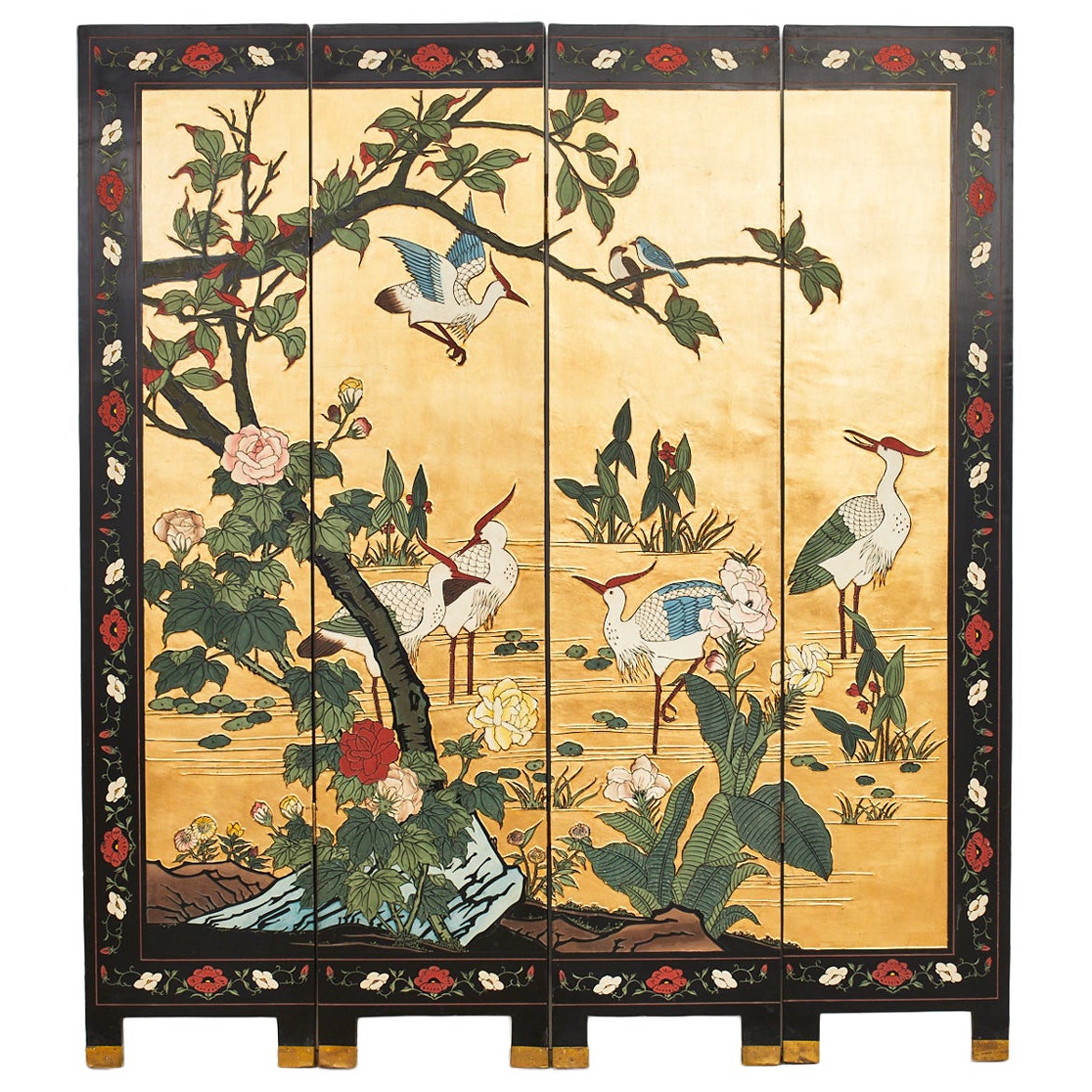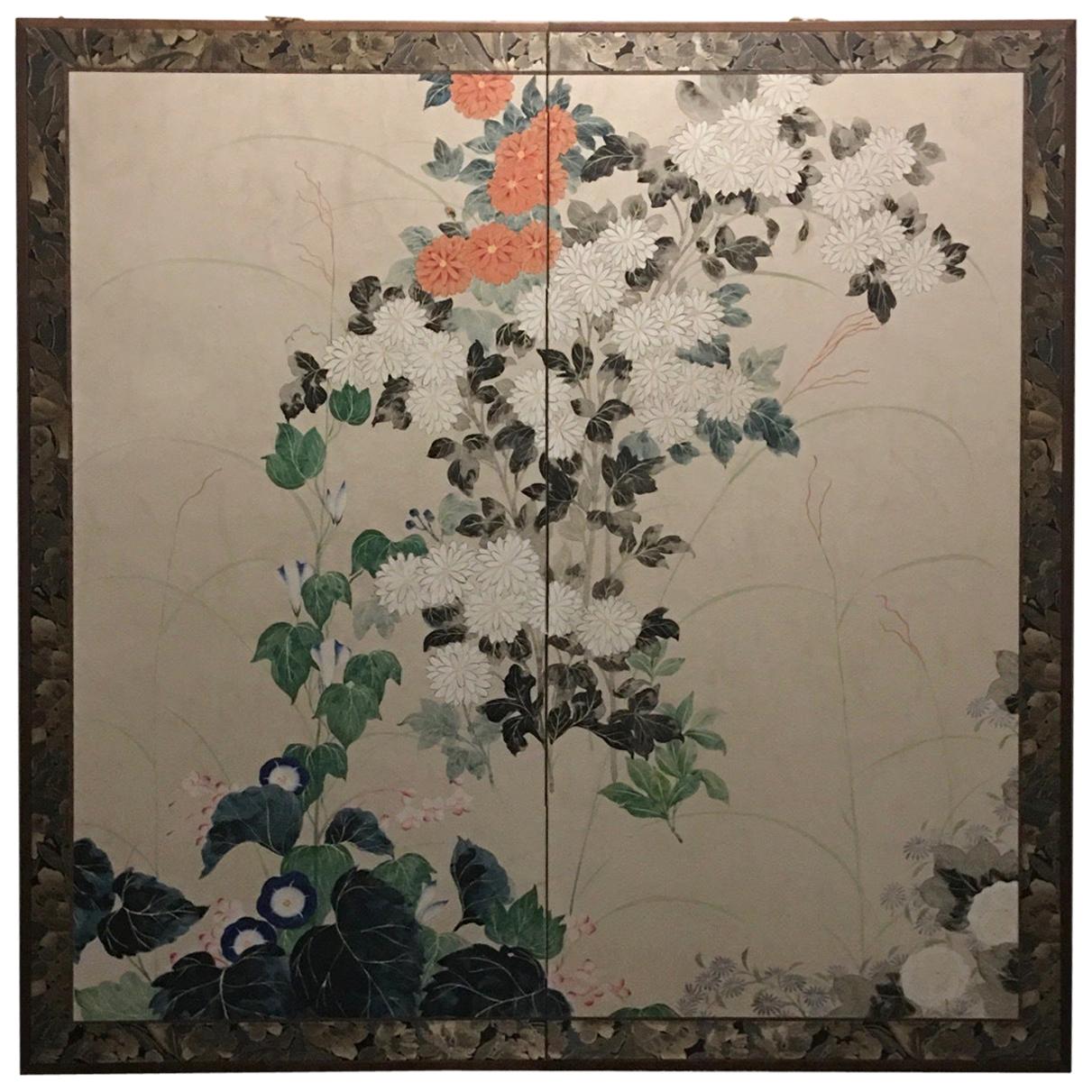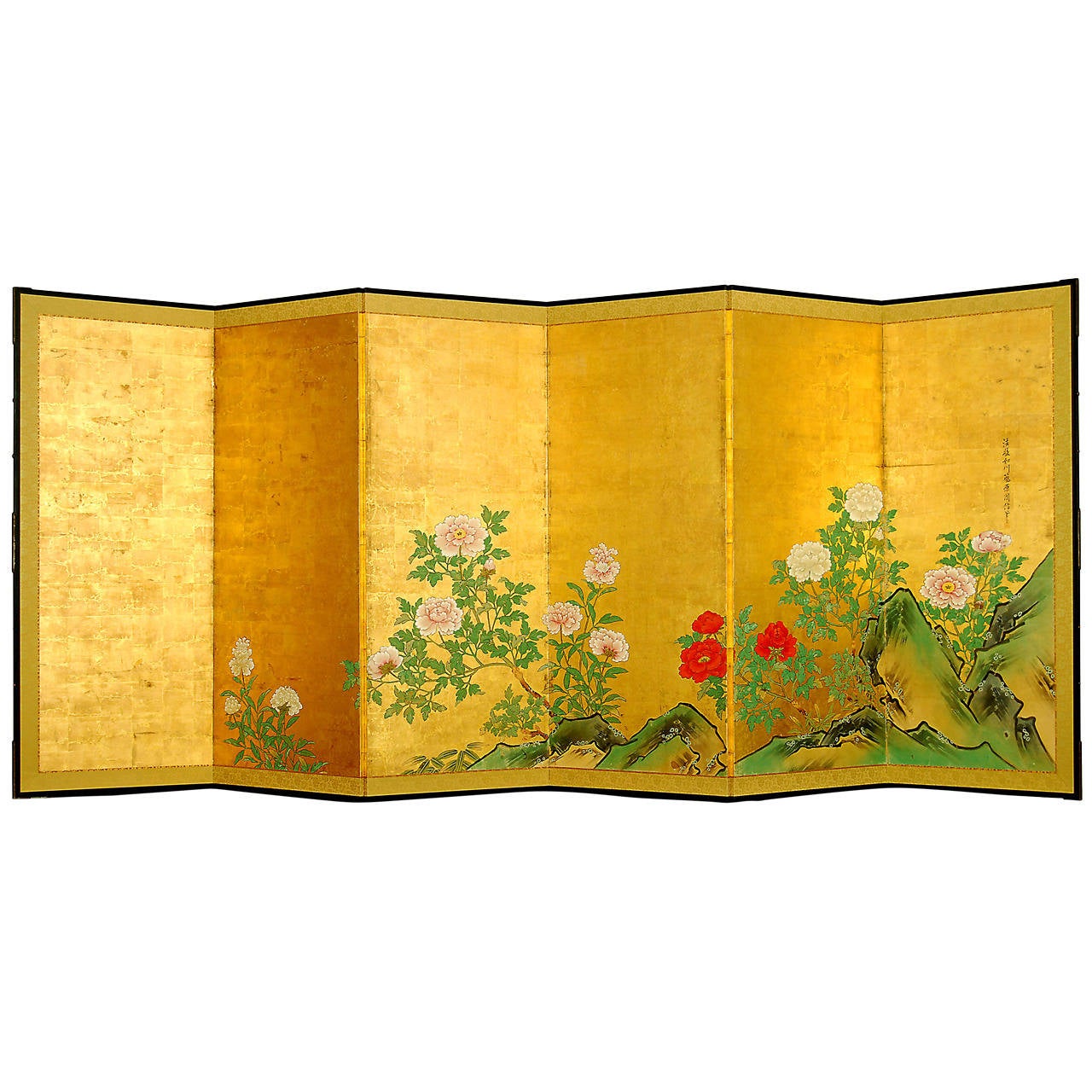Items Similar to Pair of Japanese Screens: ink paintings of peacocks on gold leaf by Imao Keinen
Want more images or videos?
Request additional images or videos from the seller
1 of 11
Pair of Japanese Screens: ink paintings of peacocks on gold leaf by Imao Keinen
About the Item
A pair of screens by Imao Keinen featuring peacocks painted in ink on gold leaf. Lacquered wood frame, brocade border, incised copper hardware.
Dimensions: H 175cm x W 352cm
Biography of Imao Keinen (1845-1924).
Imao Keinen was born in Kyoto in 1845, the fifth son of Imao Inosuke.
He first studied Ukiyo-e style with Umegawa Tōkyo, later he became a pupil of Suzuki Hyakunen, studying painting and calligraphy. He also studied other styles than those of his masters, which resulted in an eclectic style. He combined his part-time study and work in his father’s business with painting in the evenings. In 1868, after the family business was lost in the upheaval marking the end of the Tokugawa period, he began his own studio. At this time Nanga painting was at its summit and many artists turned to Nanga, but Keinen remained true to his own style. At the same time he worked as a design adviser for a textile company to make a living.
In 1888 he became professor at the Kyoto Prefectural School of Painting. Keinen was a frequent exhibitor and prize-winner at many shows and exhibitions in Japan and in Paris and an important figure in Kyoto art circles. In 1904 he became a member of the Art Committee of the Imperial Household, and in 1907 a juror for the first Bunten. In 1919 he became a member of the Imperial Art Academy. In this period of his life he was probably the most famous painter of his time.
His recurring themes are flowers, birds and landscapes. He refrained from figure-painting.
Imao Keinen had many pupils, some of the best known are his son Imao Keishō (1902-1993), Konoshima Ōkoku (1877-1938), Ueda Banshū, Kobayashi Gokyō and Shiba Kaisen. He died in 1924.
References:
Araki, Tsune (ed), Dai Nihon shôga meika taikan, Tokyo 1975 (1934), p.2049
Morioka, Michiyo and Paul Berry, Modern Masters of Kyoto, Seattle 1999, pp. 122-125
Roberts, Laurance P., A Dictionary of Japanese Artists, New York, 1976, p. 53.
- Creator:Imao Keinen (Artist)
- Dimensions:Height: 69.3 in (176 cm)Width: 128.35 in (326 cm)Depth: 7.88 in (20 cm)
- Sold As:Set of 2
- Style:Meiji (Of the Period)
- Materials and Techniques:
- Place of Origin:
- Period:
- Date of Manufacture:Unknown
- Condition:
- Seller Location:Prahran, AU
- Reference Number:
About the Seller
5.0
Vetted Seller
These experienced sellers undergo a comprehensive evaluation by our team of in-house experts.
Established in 1979
1stDibs seller since 2015
76 sales on 1stDibs
- ShippingRetrieving quote...Ships From: Prahran, Australia
- Return PolicyThis item cannot be returned.
More From This SellerView All
- Antique Japanese Six-Panel Screen by Kano ChikanobuLocated in Prahran, VictoriaLate 17th century Kano school peony landscape screens. One of a pair of screens signed: Hogan Josen Fujiwara Chikanobu Hitsu - Kano Chikanobu (Shushin) ...Category
Antique Early 18th Century Japanese Edo Paintings and Screens
MaterialsGold Leaf
- Antique Japanese Six-Panel Screen by Kano Chikanobu "Shushin"Located in Prahran, VictoriaLate 17th century Kano school peony landscape screens. Both screens signed: Hogan Josen Fujiwara Chikanobu Hitsu - Kano Chikanobu (Shushin) (1660 - 1728...Category
Antique Early 18th Century Japanese Edo Paintings and Screens
MaterialsGold Leaf
- Antique Japanese Kano School Painting by Yosenin KorenobuLocated in Prahran, VictoriaSix-panel Kano School tiger screen by Yosenin Korenobu (1753-1808). Sumi-e ink on paper, late 18th century. Dimensions: H 169cm x W 382cm.Category
Antique Late 18th Century Japanese Edo Paintings and Screens
MaterialsWood, Paper
- Vintage Japanese Two-Panel Screen, Taisho Period, Early 20th CenturyLocated in Prahran, VictoriaJapanese two-panel screen, study of an Okinawan mother and child, Taisho period early 20th century, dating from the 1920's. Signed by Matsumura Baiso, (1884-1935). Baiso was a studen...Category
Early 20th Century Japanese Taisho Paintings and Screens
- 18th Century Japanese Painting of Red and White Peonies on a Gold Leaf GroundLocated in Prahran, VictoriaThis beautiful stylized depiction of red and white peonies once adorned a traditional four panel screen. Now it sits within its handmade frame, ready to grace your walls. The peony i...Category
Antique 18th Century Japanese Paintings and Screens
MaterialsGold Leaf
- Contemporary Japanese Screen with KimonoLocated in Prahran, VictoriaContemporary Japanese two-panel screen created in the traditional manner, using vintage kimono textile on a paper ground, employing quality fittings. Ma...Category
20th Century Japanese Paintings and Screens
MaterialsFabric, Lacquer, Paper
You May Also Like
- Chinese Export Four Panel Coromandel Screen Cranes on Gold LeafLocated in Rio Vista, CADazzling Chinese export lacquered four-panel coromandel screen featuring a flora and fauna waterscape with stylized cranes. The carved lacquer panels are embellished with vivid color...Category
20th Century Chinese Chinese Export Paintings and Screens
MaterialsBrass, Gold Leaf
- Japanese Edo Six-Panel Silver Leaf Screen with Chinese Brush CalligraphyLocated in Rio Vista, CALarge Japanese Edo period six-panel folding silver leaf screen featuring Chinese style brush calligraphy of a poem. Squares of silver leaf with a vintage patina and calligraphy script on verso as seen in losses. The front of the screen decorated with large Buddhist...Category
Antique 19th Century Japanese Edo Paintings and Screens
MaterialsSilver Leaf, Brass
- Japanese Two-Panel Folding Screen with Chrysanthemums and Morning GloriesLocated in New York, NYJapanese Meiji/Taisho period two panel folding screen richly painted on Mulberry paper and depicting chrysanthemums and morning glories on a ivory background. The piece is framed by ...Category
Vintage 1910s Japanese Meiji Paintings and Screens
MaterialsWood, Paper
- Japanese Four Panel Paper ScreenLocated in Essex, MAPair of two panel screens with a rooster and a hen in amongst bamboo. Signed by the artist Ema Saiko 1787-1861. A Japanese painter, poet and calligrapher celebrated for her Chinese...Category
Antique 1850s Japanese Screens and Room Dividers
MaterialsPaper
- Japanese Edo Period Two-Panel ScreenLocated in Stamford, CTA Japanese Edo Period two panel folding screen with white and brown hawks of ink and color on paper.Category
Antique Mid-19th Century Japanese Edo Paintings and Screens
MaterialsPaper
- Vintage Japanese "Flower Cart" Folding ScreenLocated in New York, NYA traditional style Japanese four panel folding screen depicting a flower cart full of red and white flowers. 10198Category
20th Century Japanese Screens and Room Dividers
Recently Viewed
View AllMore Ways To Browse
Modern Screens
Used Screens
Wood Screens Modern
Japanese Wood Painting
Japan Paint Leaf
Gold Leaf Painting Japan
Japanese Painting Gold Leaf
Asian Gold Leaf Art
Birds Pair Gold
Asian Framed Gold
Japanese Painting On Gold Leaf
Japanese Painting With Gold Leaf
Pair Of Flower Paintings
Gold Leaf Art Pair
Japanese Screen Ink
Japan Ink Wood
Japanese Hardware
Japanese Painting With Birds





